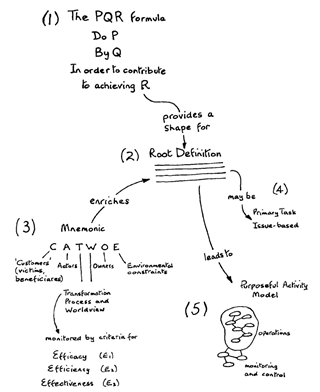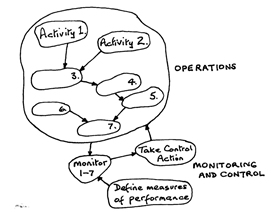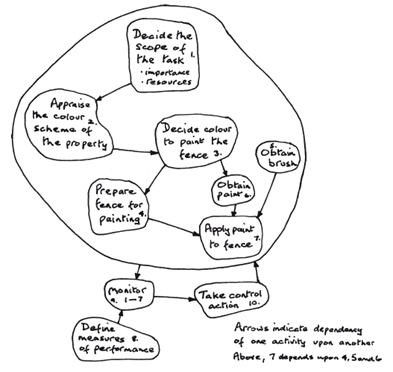Model Building - Human Activity Systems
Once insight in the problematic situation has been gained in the finding out phase, detailed models of the situation can be devised. In SSM this is done by means of Human Activity System (HAS). A HAS can be defined as a notional system (i.e., not existing in any tangible form) in which human beings are undertaking some activities that achieve some purpose. They are used in SSM to establish worldviews of people involved in a problematic situation. The assumption is that people are inclined to act purposefully according to their worldviews.
A worldview (Weltanschauung) captures the beliefs, desires and intentions of a person. In 'Learning for action (Peter Checkland and John Poulter, 1 januari 2006)', the example is given of the purpose of putting an offender in prison. It may be seen as a place for punishment, as a process of rehabilitation, or as a university for educating criminals. A person almost never adheres to a single worldview, instead elements of worldviews are typically combined. And this is the purpose of SSM: accommodating worldviews to find acceptable ways for all involved to change.
Statement: A worldview (Weltanschauung) captures the beliefs, desires and intentions of a person.
Aspect: Worldview, Principle: Diversity in opinions, Principle page: Principles and Ground Rules
| Statement page | Statement |
|---|---|
| Model Building - Human Activity Systems | The PQR formula (what, how, why) is pivotal for capturing worldviews. |
| Model Building - Human Activity Systems | A worldview (Weltanschauung) captures the beliefs, desires and intentions of a person. |
| Soft Systems Thinking – Soft Systems Methodology | People differ in worldviews, but nevertheless they typically adhere to aspects of multiple worldviews, which provides room for accommodation. |
Principles, aspects and statements overview
- We got to move, defined in page: Principles and Ground Rules
- Tradition, defined in page: Principles and Ground Rules
- Exploring Change (A system has to become what it is not, and yet remain the same.)
- Some-thing from No-thing (The relationship between things, including humans, is what matters. Something or someone cannot stand or be taken on its own.)
- Reflexive Domain, defined in page: Principles and Ground Rules
- Exploring Change (The constant factor in life is movement.)
- Self-Reference in a Three-Valued System (Embrace the paradox, i.e., a difference in what was previously stated and therefore contradicting what was said before. Differences keep setting things in motion. Without differences we cease to exist. Therefore, change is inevitable, in fact, it is a necessity for living.)
- The Autopoietic Turn (Humans and social systems operate autonomously and my react when irritated.)
- Diversity in opinions, defined in page: Principles and Ground Rules
- Worldview, defined in page: Principles and Ground Rules
- Model Building - Human Activity Systems (The PQR formula (what, how, why) is pivotal for capturing worldviews.)
- Model Building - Human Activity Systems (A worldview (Weltanschauung) captures the beliefs, desires and intentions of a person.)
- Soft Systems Thinking – Soft Systems Methodology (People differ in worldviews, but nevertheless they typically adhere to aspects of multiple worldviews, which provides room for accommodation.)
- Create room for change, defined in page: Principles and Ground Rules
- Systems Thinking, defined in page: Principles and Ground Rules
- Hard Systems Thinking – System Dynamics (A system comprised of a number of interacting feedback loops is a complex system whose behavior can surprise us.)
- Systems Thinking (A system as a whole is comprised of parts. Systems thinking is about understanding the interactions between the parts.)
- Critical Reflection, defined in page: Principles and Ground Rules
- Determining Boundary Judgements with CSH (A constructive dialog can take place on the basis of first and second order boundary judgments.)
- Self-observation (Concentrate on how to look, instead of what to see.)
- Self-observation (You need someone else to point out your blind spots to you.)
- Determine the right direction, defined in page: Principles and Ground Rules
- Cultural Identity, defined in page: Principles and Ground Rules
- Investigating Identity (Group identity refers to a person’s sense of belonging to a particular group.)
- Research Philosophy and Process (Research approach must be “for you, and with you”, instead of “for you, but not with you”.)
- Right Things, defined in page: Principles and Ground Rules
- Co-dependency, defined in page: Principles and Ground Rules
- Ethics of Care, defined in page: Principles and Ground Rules
- Investigating Identity (Ethics of Care is a retreat to first principles to be part of a group to protect and to provide meaning.)
- Responsible Setting for Social Innovation (Each stakeholder facilitates other stakeholders in addressing a societal challenge.)
- Some-thing from No-thing (We rely on each other and therefore we should care for each other.)
A HAS in SSM is made up of several elements, including the PQR formula and CATWOE eventually leading to a Purposeful Activity Model (PAM). For the sake of completeness, a distinction can be made between the scope of a SSM investigation: Primary Task (PT) or Issue-Based (IB). A PT kind of investigation focuses on the core business of an organization or a department. The system boundary coincides with these organizational units. A problematic situation that cuts across organizational boundaries are considered of IB type. For modeling activities, the distinction between PT and IB is not important. However, it does matter in a SSM investigation because stakeholders tend to think in terms of existing PT structures, which can hamper to take on a broader IB view. So, the notion of PT and IB type of investigation can be kept in mind to avoid the pitfall of being trapped in small mindsets.
PQR Formula
A worldview is defined concisely in a Root Definition (RD). A RD is shaped by the PQR formula and enriched by CATWOE. Again, an example of a RD shaped by PQR is taken from 'Learning for action (Peter Checkland and John Poulter, 1 januari 2006)'.A householder-owned and staffed system to paint the garden fence, by hand-painting, in keeping with the overall decoration scheme of the property in order to enhance the appearance of the property.The PQR formula should be read as a sentence: Do P by Q in order to contribute to achieve R. The letters P, Q and R stand for:
- P – what;
- Q – how;
- R – why.
Statement: The PQR formula (what, how, why) is pivotal for capturing worldviews.
Aspect: Worldview, Principle: Diversity in opinions, Principle page: Principles and Ground Rules
| Statement page | Statement |
|---|---|
| Model Building - Human Activity Systems | The PQR formula (what, how, why) is pivotal for capturing worldviews. |
| Model Building - Human Activity Systems | A worldview (Weltanschauung) captures the beliefs, desires and intentions of a person. |
| Soft Systems Thinking – Soft Systems Methodology | People differ in worldviews, but nevertheless they typically adhere to aspects of multiple worldviews, which provides room for accommodation. |
Principles, aspects and statements overview
- We got to move, defined in page: Principles and Ground Rules
- Tradition, defined in page: Principles and Ground Rules
- Exploring Change (A system has to become what it is not, and yet remain the same.)
- Some-thing from No-thing (The relationship between things, including humans, is what matters. Something or someone cannot stand or be taken on its own.)
- Reflexive Domain, defined in page: Principles and Ground Rules
- Exploring Change (The constant factor in life is movement.)
- Self-Reference in a Three-Valued System (Embrace the paradox, i.e., a difference in what was previously stated and therefore contradicting what was said before. Differences keep setting things in motion. Without differences we cease to exist. Therefore, change is inevitable, in fact, it is a necessity for living.)
- The Autopoietic Turn (Humans and social systems operate autonomously and my react when irritated.)
- Diversity in opinions, defined in page: Principles and Ground Rules
- Worldview, defined in page: Principles and Ground Rules
- Model Building - Human Activity Systems (The PQR formula (what, how, why) is pivotal for capturing worldviews.)
- Model Building - Human Activity Systems (A worldview (Weltanschauung) captures the beliefs, desires and intentions of a person.)
- Soft Systems Thinking – Soft Systems Methodology (People differ in worldviews, but nevertheless they typically adhere to aspects of multiple worldviews, which provides room for accommodation.)
- Create room for change, defined in page: Principles and Ground Rules
- Systems Thinking, defined in page: Principles and Ground Rules
- Hard Systems Thinking – System Dynamics (A system comprised of a number of interacting feedback loops is a complex system whose behavior can surprise us.)
- Systems Thinking (A system as a whole is comprised of parts. Systems thinking is about understanding the interactions between the parts.)
- Critical Reflection, defined in page: Principles and Ground Rules
- Determining Boundary Judgements with CSH (A constructive dialog can take place on the basis of first and second order boundary judgments.)
- Self-observation (Concentrate on how to look, instead of what to see.)
- Self-observation (You need someone else to point out your blind spots to you.)
- Determine the right direction, defined in page: Principles and Ground Rules
- Cultural Identity, defined in page: Principles and Ground Rules
- Investigating Identity (Group identity refers to a person’s sense of belonging to a particular group.)
- Research Philosophy and Process (Research approach must be “for you, and with you”, instead of “for you, but not with you”.)
- Right Things, defined in page: Principles and Ground Rules
- Co-dependency, defined in page: Principles and Ground Rules
- Ethics of Care, defined in page: Principles and Ground Rules
- Investigating Identity (Ethics of Care is a retreat to first principles to be part of a group to protect and to provide meaning.)
- Responsible Setting for Social Innovation (Each stakeholder facilitates other stakeholders in addressing a societal challenge.)
- Some-thing from No-thing (We rely on each other and therefore we should care for each other.)
A householder-owned and staffed system to paint the garden fence (P - what), by hand-painting (Q - how), in keeping with the overall decoration scheme of the property in order to enhance the appearance of the property (R - why).As will become clear, the PQR formula is key in the Expertise Management Methodology (EMM), which is centered around the Expertise Management ontology (EMont). The use of the PQR formula in EMM and EMont is refined in the sense that it can be applied recursively and in different contexts. By doing so, the descriptive power of the PQR formula is greatly enhanced.
A crucial aspect of the PQR formula is the distinction between the what and the how. It is the difference between what a person or organization does versus how it is done. A “P-what” cannot be implemented except through a particular “Q-how”. A “how” is observable, it is a particular way of doing things. Typically, it is the result of many decisions over the years at different levels, or a consequence of ad-hoc responses to changing conditions (see 'Soft Systems Thinking, Methodology and the Management of Change (Brian Wilson and Kees Van Haperen, 1 januari 2015)'). An observable “how” that is historically evolved in what it is today tend to obscure the reason why we do particular things in the first place. This might actually inhibit change because a “how” may become a unalterable rule of how things must be done. The PQR formula provides a structure to re-assess purpose and to find new ways to act purposefully.
CATWOE
The CATWOE is here only elaborated to a certain extent because it is in our approach superseded by EMont. Nevertheless, the CATWOE provides useful elements to enrich a RD that will be discussed here, but these elements do have their counterpart in EMont.
CATWOE stands for:
- Customers - Who are the beneficiaries of the highest level business process and how does the issue affect them?
- Actors - Who is involved in the situation, who will be involved in implementing solutions and what will impact their success?
- Transformation Process - What is the transformation that lies at the heart of the system - transforming grapes into wine, transforming unsold goods into sold goods, transforming a societal need into a societal need met?
- Weltanschauung - What is the big picture and what are the wider impacts of the issue?
- Owner - Who owns the process or situation being investigated and what role will they play in the solution?
- Environmental Constraints - What are the constraints and limitations that will impact the solution and its success?
The primary goal of CATWOE is to define a transformation process and its context. The quality of this process can be guided with the three E’s:
- Efficacy – does the transformation process actually works?
- Efficiency – is the transformation process achieved with as minimal resource usage as possible?
- Effectiveness – is the transformation process capable of producing the intended results and to what extent and does it not have undesirable side-effects?
Two E’s may be added to this list: is the transformation process an Elegant transformation and is it Ethically justified.
Purposeful Activity Model
A Purposeful Activity Model (PAM) is described in terms a activities within the context of a Root Definition (RD), which is shaped by a PQR formula and enriched with CATWOE. The general shape of a PAM is shown below. The transformation process is comprised of sequences of activities, which are controlled by a monitor and control process. The measure of performance for monitoring and control can be derived from the 3/5 E’s as defined in a CATWOE.
The monitoring and control activities resemble a Plan-Do-Check-Act/Adjust (PDCA) cycle (also known as the Deming wheel of continuous improvement) for monitoring and guiding continuous improvement in manufacturing processes (cite{?}). A plan is made that includes the determination of objectives. Next, the plan is executed in the Do-phase and data of this phase is gathered. The results are evaluated by checking the preset objectives against the realized outcomes of the Do-phase. Typically, some deficiencies are identified. In the Act-phase (sometimes called Adjust-phase), the identified deficiencies are dealt with by investigating promising improvements. These are implemented in a next PDCA-cycle. The PDCA-cycle are repeated several times until the objectives are realized sufficiently by means of adapted ways of doing things in the Do-phase.
A parallel with negative feedback loops in SD models is easy to see. The difference between a preset objective and the realization thereof steers an adjustment process. The PDCA-cycle can be adapted to many situations. For instance, in applications of EMont, it is shown how the PDCA-cycle can be part of a human cognition and behavior model to reflect on one’s own behavior.
The painting example shown below demonstrates how these general modelling elements can be applied in a concrete application. As is the case for CATWOE, the PAM is superseded in our approach by EMont, which has a richer set of elements to define activities and purpose more precisely.




